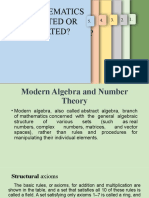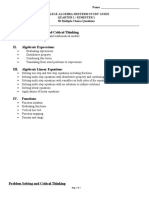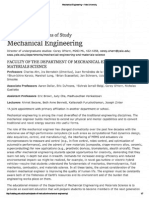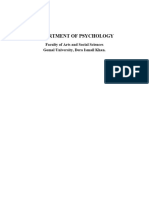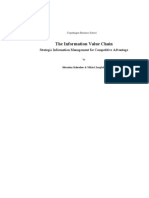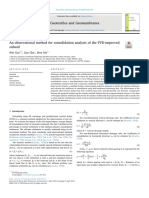History of Number Theory
Uploaded by
LiezlLzeilCarreonGalgoHistory of Number Theory
Uploaded by
LiezlLzeilCarreonGalgoHistory of number theory.
Most areas of mathematics go from inception to
maturity within at most a century. But in number theory there are questions
that were formulated more than 2000 years ago (such as whether any odd
perfect numbers exist) that have still not been answered. Of the principles
that have been established in number theory, a great many were first
revealed by explicit experiments. From its inception in classical ×,
through its development in the 1600s to 1800s, number theory was largely
separate from other fields of mathematics. But starting at the end of the
1800s, increasing connections were found to other areas of both continuous
and discrete mathematics. And through these connections, sophisticated
proofs of such results as Fermat’s Last Theorem - open for 350 years - have
been constructed. Long considered a rather esoteric branch of mathematics,
number theory has in recent years grown in practical importance through its
use in areas such as coding theory, cryptography and statistical mechanics.
Properties of numbers and certain elementary aspects of number theory have
also always played a central role in amateur and recreational mathematics.
And as this chapter indicates, number theory can also be used to provide
many examples of the basic phenomena discussed in this book.
History
The early Greek mathematicians (before 500 BCE) knew only the (positive)
integers and their quotients (rational numbers). Numbers were both an area
of academic study and a source of mysticism. The discovery of irrational
numbers, those that could not be written as quotients of integers, was a
major psychological and intellectual blow. Even after this traumatic event,
the Greek mathematicians continued to place the integers in an exalted
role. Plato says, "Arithmetic" [the study of numbers] "has a very great and
elevating effect, compelling the mind to reason about abstract number."
Until recently, Number Theory continued to hold the same pride of place as
the most beautiful, most "pure," and least applicable of the fields of
mathematics. As both art and intellectual training, it has been part of
education and research for thousands of years. The early 20th century
mathematician G. H. Hardy took great pride in the belief that number theory
was the height of both beauty and uselessness.
Cryptology, the study of encoding messages that could be read only by the
intended recipient, is as old as warfare and political intrigue. The
obvious and historical methods relied on a two-way key. The writer of the
message used the key to encode it, and the recipient used the same key to
decode it. Some keys were harder than others to guess, or "crack," but all
keys had the disadvantage that they must somehow be communicated between
sender and recipient. On the way, they could be stolen.
In the 1970s, a different system of cryptography was invented. In this
system, there are two different keys, one to encode, or encrypt, and the
other to decode, or decrypt. The encryption key can be public; only the
decryption key need be kept private, and only one party needs to have it.
This is the kind of system currently in widest use. It was about this time
that the internet began to gain importance, and it has become one of the
largest users of encryption. It turns out that Number Theory, specifically
the branch involving prime numbers, is the major tool in making these
encryptions systems work. Number Theory is not so useless after all.
You might also like
- (Hua Loo Keng) Introduction To Number Theory100% (1)(Hua Loo Keng) Introduction To Number Theory588 pages
- Kato, Kurokawa, Saito - Number Theory I. Fermat's Dream S86% (7)Kato, Kurokawa, Saito - Number Theory I. Fermat's Dream S157 pages
- The Story of Mathematics: From creating the pyramids to exploring infinityFrom EverandThe Story of Mathematics: From creating the pyramids to exploring infinity4/5 (8)
- Secrets of Number Theoretic Tools in Network Security Algorithms of Public-Key CryptosystemsNo ratings yetSecrets of Number Theoretic Tools in Network Security Algorithms of Public-Key Cryptosystems25 pages
- Number Theory in Science and Communication Schroeder PDF100% (2)Number Theory in Science and Communication Schroeder PDF423 pages
- Cryptography From The Ancient History To NowNo ratings yetCryptography From The Ancient History To Now20 pages
- Application of Number Theory in CryptographyNo ratings yetApplication of Number Theory in Cryptography4 pages
- (Discrete Mathematics and Its Applications) Moreno, Carlos J. - Wagstaff, Jr. Samuel S - Sums of Squares of Integers-CRC Press (2005)No ratings yet(Discrete Mathematics and Its Applications) Moreno, Carlos J. - Wagstaff, Jr. Samuel S - Sums of Squares of Integers-CRC Press (2005)363 pages
- An Application To Cryptography Using Fermat's TheoremNo ratings yetAn Application To Cryptography Using Fermat's Theorem3 pages
- Development of Numbers: Reporters & Editors: Kenzhin Lorenzo & Ruzzel James GlorianeNo ratings yetDevelopment of Numbers: Reporters & Editors: Kenzhin Lorenzo & Ruzzel James Gloriane11 pages
- Elementary Number Theory 2nd Edition Underwood Dudley - Read the ebook online or download it as you prefer100% (1)Elementary Number Theory 2nd Edition Underwood Dudley - Read the ebook online or download it as you prefer50 pages
- Describe What Mathematics Do? Is Mathematics Invented or Created?No ratings yetDescribe What Mathematics Do? Is Mathematics Invented or Created?34 pages
- A Course in Number Theory and Cryptology: Rajat TandonNo ratings yetA Course in Number Theory and Cryptology: Rajat Tandon4 pages
- C. Stanley Ogilvy, John T. Anderson-Excursions in Number Theory-Oxford UP (1966)No ratings yetC. Stanley Ogilvy, John T. Anderson-Excursions in Number Theory-Oxford UP (1966)172 pages
- Branches of Maths Arithmetic, Algebra, Geometry, Calculus, Statistics, TopologyNo ratings yetBranches of Maths Arithmetic, Algebra, Geometry, Calculus, Statistics, Topology1 page
- Elementary Cryptanalysis by Sinkov, Abraham (Z-lib.org)No ratings yetElementary Cryptanalysis by Sinkov, Abraham (Z-lib.org)227 pages
- Lesson 4 Number Theory and CryptographyNo ratings yetLesson 4 Number Theory and Cryptography13 pages
- Instant Access to Number Theory revealed Chapters 1 2 Fall 2018 Andrew Granville ebook Full Chapters100% (1)Instant Access to Number Theory revealed Chapters 1 2 Fall 2018 Andrew Granville ebook Full Chapters55 pages
- Rosen - Elementary Number Theory and Its ApplicationsNo ratings yetRosen - Elementary Number Theory and Its Applications462 pages
- Asymmetric Ciphers: Unit III Prepared By: Suresh Thapa, Vedas College, Jawalakhel, NepalNo ratings yetAsymmetric Ciphers: Unit III Prepared By: Suresh Thapa, Vedas College, Jawalakhel, Nepal44 pages
- A Survey Taken at A Hotel in Malate Indicated That 40guests Preferred The Following Means of TransportationNo ratings yetA Survey Taken at A Hotel in Malate Indicated That 40guests Preferred The Following Means of Transportation6 pages
- MATH 324 Summer 2006 Elementary Number Theory Solutions To Assignment 2 Due: Thursday July 27, 2006No ratings yetMATH 324 Summer 2006 Elementary Number Theory Solutions To Assignment 2 Due: Thursday July 27, 200610 pages
- Analysis of Covariance: Dummy Variables) Z Z X Y ENo ratings yetAnalysis of Covariance: Dummy Variables) Z Z X Y E8 pages
- Analysis of Covariance: Dummy Variables) Z Z X Y ENo ratings yetAnalysis of Covariance: Dummy Variables) Z Z X Y E8 pages
- College Algebra Midterm Study Guide Sem1No ratings yetCollege Algebra Midterm Study Guide Sem15 pages
- System Satisfaction: SS1 SS2 SS3 SS4 SS5No ratings yetSystem Satisfaction: SS1 SS2 SS3 SS4 SS53 pages
- Chapters 1 To 7 Practice Multiple Choice Fall 2013No ratings yetChapters 1 To 7 Practice Multiple Choice Fall 201316 pages
- Case Study: Alex Charter School: Journal of Business Case Studies - July/August 2010 Volume 6, Number 4No ratings yetCase Study: Alex Charter School: Journal of Business Case Studies - July/August 2010 Volume 6, Number 46 pages
- 6 One Wayancova 150624231823 Lva1 App6891 PDFNo ratings yet6 One Wayancova 150624231823 Lva1 App6891 PDF15 pages
- Bio-Data (DR.P.K.sharMA) As On 13th June 2023No ratings yetBio-Data (DR.P.K.sharMA) As On 13th June 202334 pages
- Mathematical Foundation: CSE 6331 Algorithms Steve LaiNo ratings yetMathematical Foundation: CSE 6331 Algorithms Steve Lai23 pages
- 7 - Chapter 7-Chapter 7 - Density-Based Clustering MethodsNo ratings yet7 - Chapter 7-Chapter 7 - Density-Based Clustering Methods30 pages
- Oswaal CBSE Class 12th Toppers Answers Year-2020 MathematicsNo ratings yetOswaal CBSE Class 12th Toppers Answers Year-2020 Mathematics17 pages
- Scheduling of Vehicles From A Central Depot To A Number of Delivery PointsNo ratings yetScheduling of Vehicles From A Central Depot To A Number of Delivery Points15 pages
- Design and Intended Use of A Passive Actuation Strategy For A 2019No ratings yetDesign and Intended Use of A Passive Actuation Strategy For A 20196 pages
- Mechanical Engineering - Yale UniversityNo ratings yetMechanical Engineering - Yale University7 pages
- MBA Second Semester / First Year Second Sessional Examination 2020-21 Quantitative Techniques For Managers (Kmbn-206) Time: 1:30 Hrs Marks: 50No ratings yetMBA Second Semester / First Year Second Sessional Examination 2020-21 Quantitative Techniques For Managers (Kmbn-206) Time: 1:30 Hrs Marks: 506 pages
- PhysicsLAB - Constant Velocity - Position-Time Graphs #2No ratings yetPhysicsLAB - Constant Velocity - Position-Time Graphs #22 pages
- Tutorial: Good Practice in Well Ties: First Break October 2003No ratings yetTutorial: Good Practice in Well Ties: First Break October 200327 pages
- Traffic Assignment: Urban Transportation Systems PlanningNo ratings yetTraffic Assignment: Urban Transportation Systems Planning29 pages
- An Observational Method For Consolidation Analysis of The PVD-improved SubsoilNo ratings yetAn Observational Method For Consolidation Analysis of The PVD-improved Subsoil9 pages
- Economic Disadvantage and Math AchievementNo ratings yetEconomic Disadvantage and Math Achievement16 pages
- Tuning of Fuzzy Logic Controller Using Genetic Algorithm: Prepared byNo ratings yetTuning of Fuzzy Logic Controller Using Genetic Algorithm: Prepared by56 pages
- Are Conversion, Selectivity and Yield Terms Unambiguously Defined in Chemical and Chemical Engineering Terminology?No ratings yetAre Conversion, Selectivity and Yield Terms Unambiguously Defined in Chemical and Chemical Engineering Terminology?10 pages



































